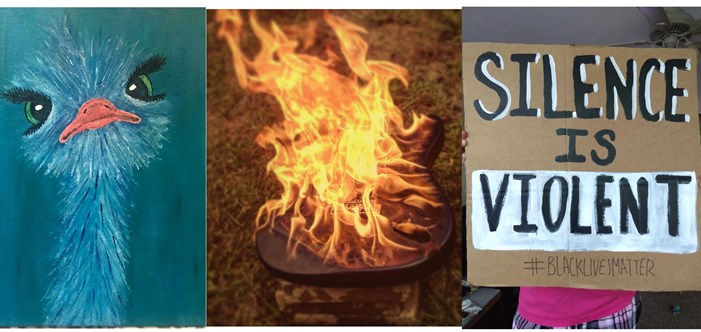Michigan State University has begun collecting art from around the world in an exploration of how people are using creativity in coping with the challenges and stresses of the COVID-19 pandemic.
Faculty members in the College of Arts and Letters have received a $3 million grant from The Andrew W. Mellon Foundation’s Just Futures Initiative for the project, Creativity in the Time of COVID-19: Art as a Tool for Combating Inequity and Injustice. The goal of the project is to provide validation, comfort and hope for all audiences by creating a community space to share collective stories of trauma, anger and joy amid COVID-19 and how art can help chart a new path for healing and justice.
When students were asked to shelter in place last spring, two MSU professors encouraged their students to use creativity to process their emotions. They responded with efforts that expanded the definition of art to include gardening, cooking and social media videos. “At some point, each student hit a low and the next day, they turned to art,” said Natalie Phillips, associate professor of English and co-principal investigator on the grant. “I did not expect this at all, and it made me so excited to see art helping them get through this difficult time. I thought, if this helped students here, what about the larger community nationally or even internationally?”
Works gathered across the globe will be featured in online and physical exhibits in Lansing, Michigan, and in satellite exhibits at the University of Buffalo; University of Washington, St. Louis; and the U.S. Air Force Academy. Through these exhibits, the professors hope to set a new standard for accessibility in museums, universities and online resources by offering Braille, American Sign Language, audio guided tours and adjusted sensory environments.
Over the next three years, Phillips, who is also the co-director of the Digital Humanities and Literary Cognition Lab; Nancy DeJoy, associate professor in the Department of Writing, Rhetoric and American Cultures; and Julian Chambliss, professor of English and co-director of the DHLC lab, will work with community partners to find and collect creative expressions from people who have been hardest hit during the pandemic. “COVID isn’t treating everyone equally,” DeJoy said. “Being stuck at home is not the same for everyone.”
Once the creative pieces have been collected, Chambliss, who is also the Val Berryman Curator of History at the MSU Museum, will create an online experience that complements the physical exhibit to preserve this pandemic art digitally.
“This project provided a unique opportunity in cataloging and preserving the creative submissions for the future,” Chambliss said. “Hopefully, people will see a story in the exhibit that reflects their trauma during the pandemic in a meaningful way.”

Dejoy and Phillips found their students’ creative pursuits demonstrated they were coping with their everyday life in myriad ways. One student who worked in MSU’s custodial services painted brightly colored birds after days of disinfecting, cleaning and sanitizing. Rebuilding a guitar, which he had previously set on fire, was another student’s way of dealing with his emotions. Another student and cancer survivor found her voice by creating protest signs for a local Black Lives Matter march.
The project aims to reframe the understanding of how people from every walk of life have found the courage to stand up, use their creativity and face societal challenges.
“We want to feature work from people who are feeling the effects of the pandemic disproportionately and are using creativity to respond in a variety of ways," DeJoy said. “We must make public spaces for these voices if we are to tell the full story of the pandemic and the inequities and structures of social injustice it exposes."